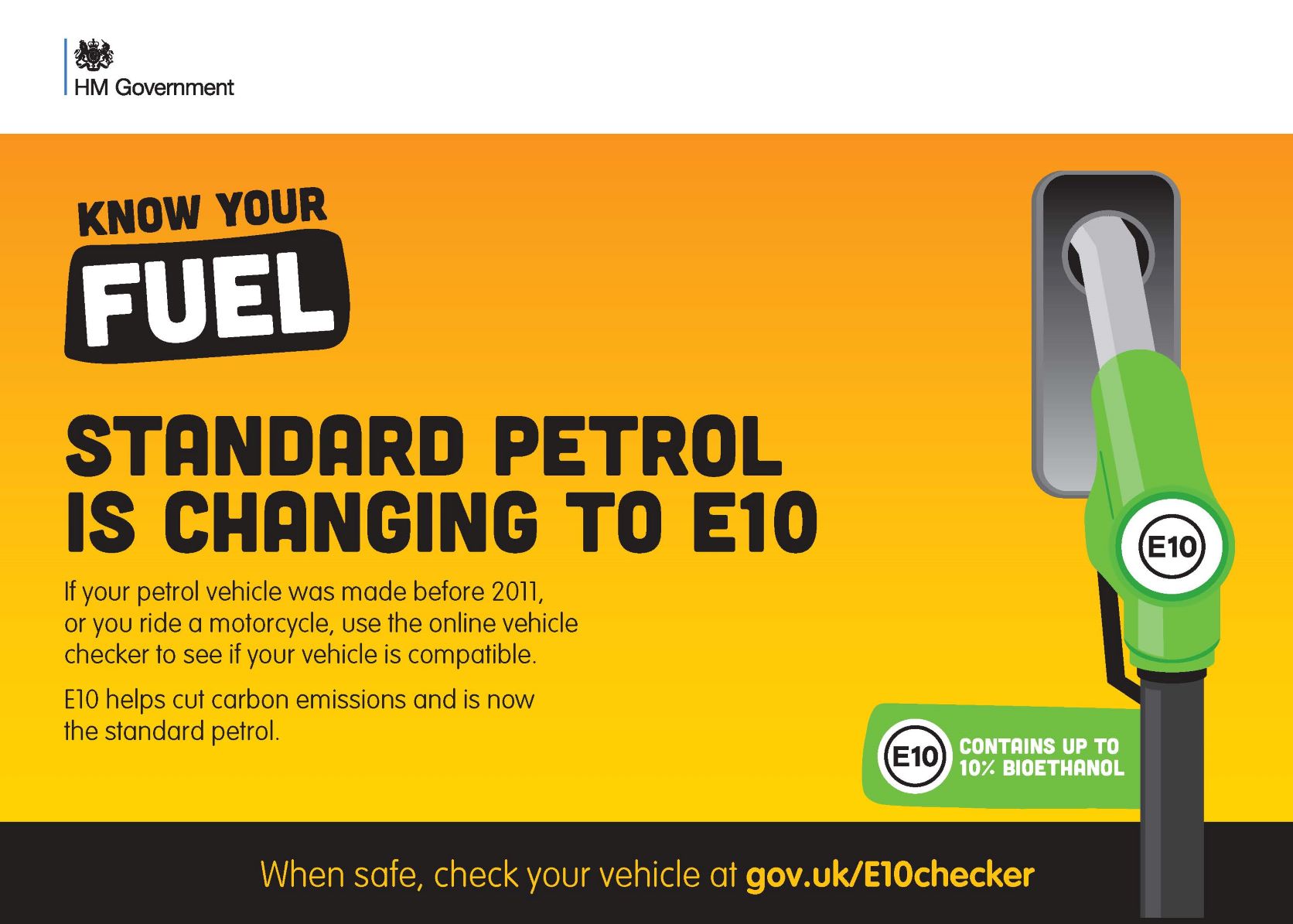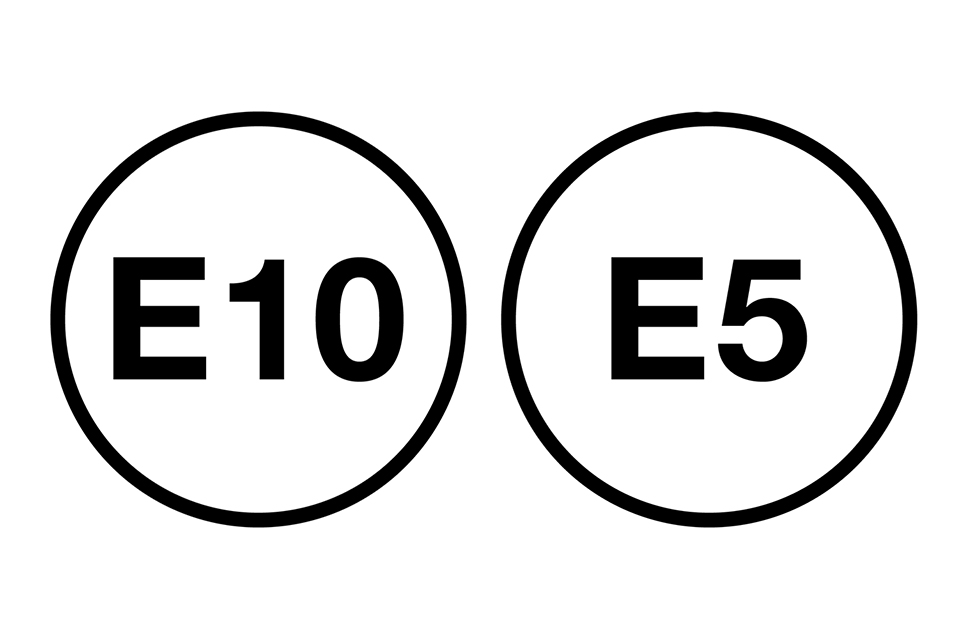Whats changing?
Over the course of summer 2021, "premium" petrol in the UK will change from E5 to E10.
E5 (premium or standard) petrol contains up to 5% renewable ethanol, which is added to reduce overall carbon dioxide (CO2) emissions. This percentage is rising to a maximum of 10% in a further effort to combat the climate impact of fossil fuels.
E10 petrol is compatible with the majority of petrol-engined vehicles on the road today, and all petrol cars built since 2011.
How does this affect me?
Most petrol cars, motorcycles and mopeds used on UK roads are compatible with the fuel. However there are a number of vehicles that the fuel shouldn't be used in. Most of these are older or "classic" models, but there are some contemporary models affected. The DVLA has created a vehicle compatibility checker to help you determine if your vehicle is affected by this change.
New vehicles manufactured from 2019 onward should have an ‘E10’ and ‘E5’ label close to the filler cap showing the fuel(s) they can use.
If your vehicle or equipment is not compatible with E10 fuel or you are unsure, "super" unleaded E5 fuel will remain available at all filling stations and you should use this instead.
Over the course of the summer 2021 you will start to see new labelling at the fuel pumps for petrol. E10 and E5 fuels will be clearly labelled and this process will be completed before any E10 fuel actually becomes available later in the year.
What if I drive a diesel?
The change in fuel only applies to petrol; diesel fuel will not be changing.
Why is this happening?
E10 petrol has been the reference fuel against which new cars are tested for emissions and performance since 2016 and is already widely used around the world, including across Europe, the US and Australia.
The main benefit of E10 petrol is that it reduces overall levels of CO2 - based vehicle emissions. By blending the fuel with up to 10% renewable ethanol, less fossil fuel is needed, helping protect the environment and meet climate change targets.
The Government claims its introduction could cut transport CO2 emissions by 750,000 tonnes a year – the equivalent of taking 350,000 cars off the road. Producing ethanol also results in valuable by-products, including animal feed and stored CO2.
However, the adoption will not improve localised air quality and pollutants such as particulates, nitrogen oxides and hydrocarbons will not be reduced. In fact, some argue that there might be a slight increase in these pollutants as a result. This is because Using E10 petrol can slightly reduce fuel economy (the number of miles you are able to drive on a gallon of fuel).
Using E10 fuel will not affect whether you are able to drive in, or have to pay to enter, a clean air zone (CAZ), low emission zone (LEZ) or ultra-low emission zone (ULEZ); this is determined by your car’s Euro emissions standard and not by the fuel used.
How will using E10 affect my vehicle?
Using E10 petrol can slightly reduce fuel economy (the number of miles you are able to drive on a gallon of fuel). There may be a reduction of 1%, which may not be noticeable in everyday driving and equates to no more than half a tankful per year for the average driver.
Other factors such as driving style, vehicle maintenance or carrying unnecessary weight would have a more significant impact on fuel economy.
Does E10 affect other petrol powered vehicles and tools?
The following vehicles may not be compatible with E10 fuel:
- Some specific models, particularly those from the early 2000s
- Classic, cherished and older vehicles
- Some mopeds, particularly those with an engine size of 50cc or under
- Some petrol powered boats
- Some petrol-powered garden equipment or machinery, such as lawnmowers and chainsaws
Owners of light aircraft that currently use E5 petrol known as MOGAS should continue to use E5 petrol, unless expressly approved by their manufacturer or regulating body.
Find out more:
Why might my vehicle not be compatible with E10?
- Corrosion – in long term storage, fuel containing Ethanol can become acidic and cause corrosion of aluminium, zinc and galvanised materials, brass, copper and lead/tin coated steels.
- Material compatibility – Ethanol's high solvency can cause problems with many seal and gasket materials used in fuel systems as well as with fibre glass resins. Besides a risk of fuel leaks, rubber components and resins can become partially dissolved, producing deposits that could foul carburettor jets. Replacement components made with Ethanol-compatible materials are available.
- Combustion – Ethanol's higher volatility can contribute to 'vapour lock' issues in older vehicles when operating temperatures are higher. Ethanol can also affect cold start performance.
What if I fill up with E10 by mistake?
Don't panic! Engines that aren't compatible with the fuel will not sustain any damage from short term use. Simply fill up with E5 (super) once there is room in the tank and continue to use the correct fuel on subsequent fill ups.
Unlike filling a petrol car with diesel (or vice-versa), there is no need to have the fuel drained.
My car is compatible with E10, can I still use E5, or mix the two?
There is no reason not to use E5 if your vehicle is able to run on E10, or to mix the two fuels.
Visit theAA.com/biofuels for more information on the use of biofuels
Check if your vehicle is compatible here
Published: 26 February 2021 | Author: The AA


